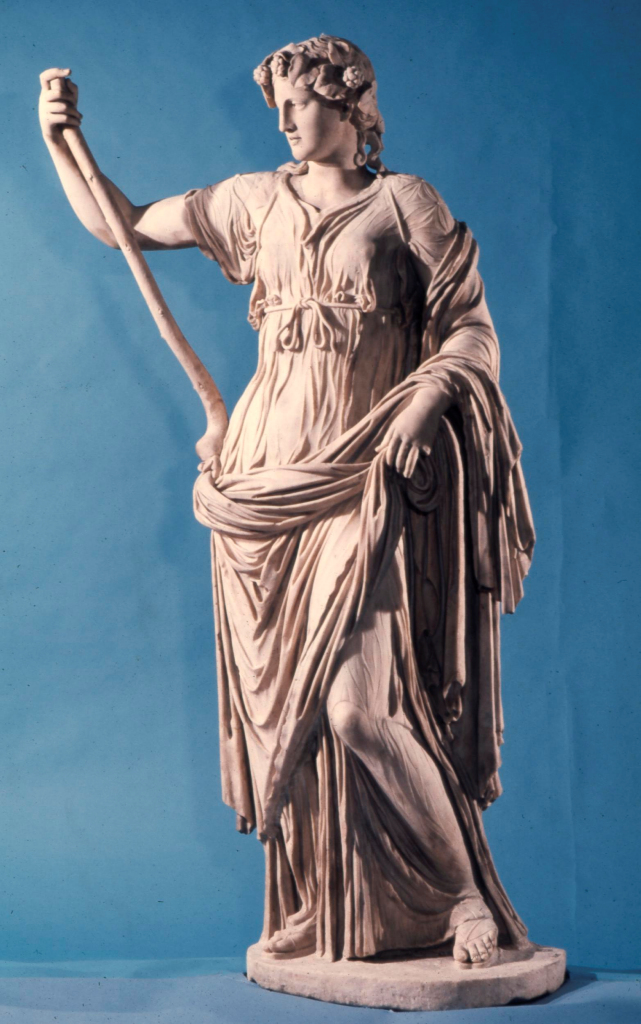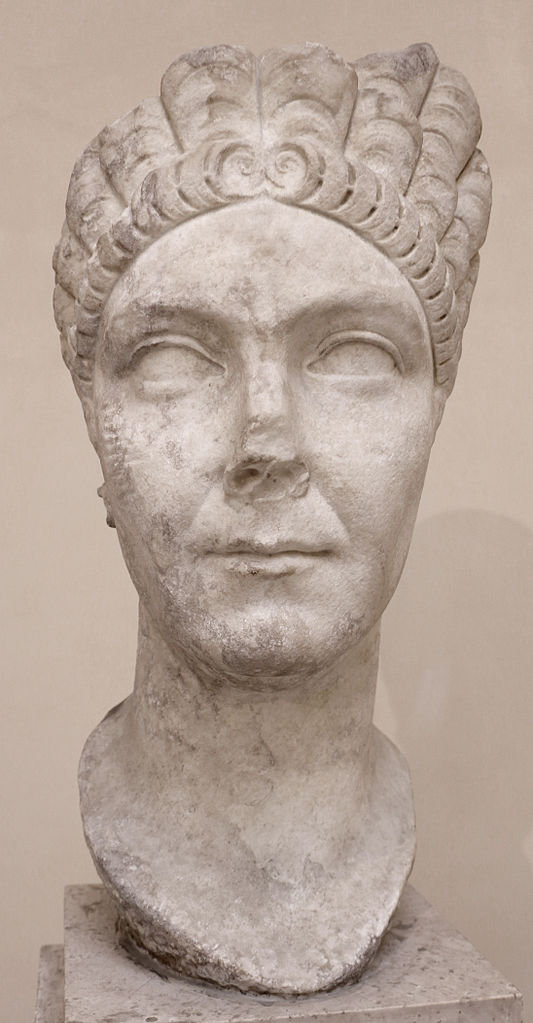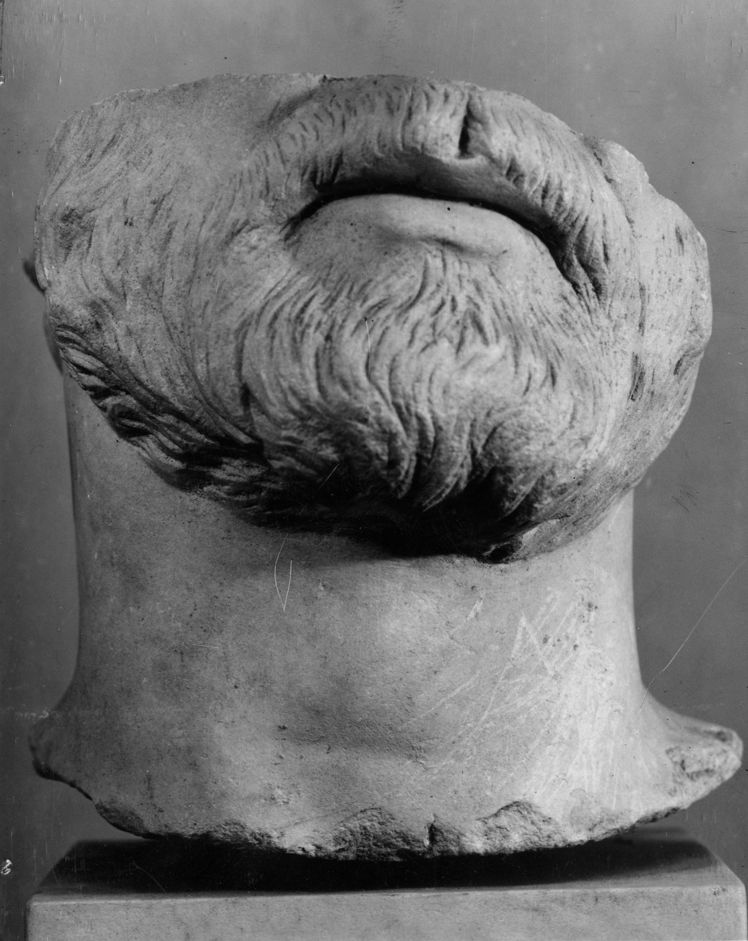The excavations
The Baths of the Marine Gate are located at a considerable distance from this gate, towards the south-east. In antiquity the baths were situated on the beach. They were searched by the Scottish painter Gavin Hamilton, who mentions the building in a letter from 1775.
Excerpts from Gavin Hamilton's letter to Lord Townsend, written in 1775, describing excavations of two baths in the area.
"Being desirous of trying my fortune somewhere near the sea, I agreed with Cardinal Serbelloni, then Bishop of that place, who granted me liberty to make some trials in that immense field of antiquity. I got as near the Sea as possible, judging it the most probable place to find objects of taste. We opened ground on a spot now called Porta Marina. From the figure of the ruins they proved to be the remains of publick Thermae Maritimae, and from the inscriptions which were found of an unusual size, it seems those Baths had been restored by different Emperors down to Constantin. I gave a very elegant one of the time of Trajan to Carlo Albagine, but what gave me greatest hopes was to find some marks of my friend Hadrian, the great protectour of fine arts and in particular that of Sculptour. I did not remain long in suspense, for the first Statue that was brought to light was the fine Antinous in the character of Abundance, perhaps the finest of that subject in the world. Mr. Bary tells me it is arrived safe at his house in England, and where I hope by this time you have had the pleasure to consider it. Near this Statue was found a very indifferent one of an Esculapius, and a large statue of his daughter Hygea, very entire, and of a great deal of merit; this Statue was sold with some other pieces of good sculptour to the Langrave of Hesse Cassel. We found next a most excellent Torso under the knees, of which there is a duplicate at the Capitol."
"Little more of consequence was found at Porta Marina, as I found that others had been there before me, so we proceeded to another Ruin on the sea shore, which from some fragments found above ground gave great hopes. A Bath was first discovered with the pavement of Verd antique and a fine Torso of a young man of which most of the other parts were found much broke, excepting the Head, notwithstanding the greatest diligence made for so interesting a discovery. The present Pope Pius VIth has ordered it to be restored for the Museum. Your small Venus holding a mirror is another of the precious ornaments of this Bath; four of the Labours of Hercules were found at some little distance from this place, which being very entire, and with their proper emblems, now add to the lustre of the Pope's Museum, to which I may add that tasty Tripod of Apollo, found near where we discovered your Mother of Venus and Muse, which, as they are in every respect two of my happiest discoveries, I am very happy that they should fall into so good hands as your own, especially as they make part of those select pieces of art which I hope will in time establish a good taste in England."The baths were later partly excavated by Pietro Campana, in the years 1831-35. Further excavations took place in the years 1922-1928, 1938-1942, 1971-1975 and 1987, followed by restoration.
The building phases
Recent research suggests that the inauguration of the baths is documented in an inscription dug up by Gavin Hamilton, now in the Vatican Museums (in the past the inscription has always been linked to the Baths of Neptune (II,IV,2)). The baths were in that case financed by Hadrian with two million sesterces and finished by Antoninus Pius with additional money and marble. The inscription is dated to late December 138 or 139 AD. Brick stamps from the building coincide with this date. The baths could well be referred to in a late historical text, the Historia Augusta, as a lavacrum Ostiense built by Antoninus Pius.

IMP(erator) CAESAR DIVI HADRIANI FIL(ius) DIVI TRAIANI PARTHICI NEP(os) DIVI [Nervae]
PRONEPOS T(itus) AELIVS HADRIANVS ANTONINVS AVG(ustus) PIVS PONTIF(ex) MAX(imus) TRIB(unicia) POTES[tat(e) II co(n)s(ul) II?]
THERMAS IN QVARVM EXSTRUCTIONEM DIVOS PATER SVVS ((sestertios)) XX ((centena milia)) POLLI[citus erat]
ADIECTA PECVNIA QVANTA AMPLIVS DESIDERABATVR ITEM MARMORIBVS AD OMNEM C[ultum fecit?]The Emperor Caesar, son of the deified Hadrian, grandson of Trajanus Parthicus and great-grandson of the deified Nerva,
Titus Aelius Hadrianus Antoninus Augustus, pontifex maximus, wth the power of tribune for the second time, consul for the second time,
delivered the baths for the construction of which his divine father had promised 2,000,000 sesterces,
after adding more money than was wished for and also marble for the entire decoration.The inscription documenting the work of Hadrian and Antoninius Pius, from 138-139 AD.
EDR094043. Photo: Vatican Museums.It could be these baths that were damaged by fire and repaired in the years 160-180 AD by a Publius Lucilius Gamala:
THERMAS QUAS DIVVS PIVS AEDIFICAVERAT VI IGNIS CONSVMPTAS REFECIT PORTICVM REPARAVIT He restored the baths built by the deified Pius, consumed by a violent fire, and repaired the porticus. Part of an inscription mentioning work by Publius Lucilius Gamala. EDR143921. Later work is documented in the frigidarium (room H). In the Severan period a new vaulted roof was installed here. Other additions are much later. First of all an apse with a basin at the north end of the frigidarium (M). The impressive brick piers of this apse have always been visible. Secondly the polychrome geometric mosaic floor of the frigidarium, made with large marble tesserae (3 to 4 cm.). During this work a base for a statue of the Emperor Probus, dated to 281 AD, was reused as a column base. The work is probably mentioned in yet another inscription, this one from the years 337-350 AD. It mentions restoration after long neglect by the Emperors Constans and Constantius II, carried out by a prefect of the Annona.

INVICTISSIMO ATQVE
INDVLGENTISSIMO
IMP(eratori) PROBO AVGVSTO
PONTIFICI MAXIMO IMPERATORI
OCTAVOM CONSVLI QVARTVM
[---]STIT[---]A dedication to Emperor Probus from 281 AD, reused and upside down.
EDR158550. Photo: Jan Theo Bakker.
[--- Cons]TANTIVS ET CONST[ans] [--- therm]AS INCVRIA LONGI TEMPORIS DESTITVTA[s ---] [---]ORVM AD PRISTINVM STATVM REFORMAN[das ---] [--- s]VIS RED[d]IDERVNT [curante ---]O V(iro) C(larissimo) PRAEFECTO ANNONA[e] CUM IVRE [gl]ADII [---] Inscription mentioning work by the Emperors Constans and Constantius II, from 337-350 AD.
EDR163863.More alterations are documented by an inscription from the years 375-378 AD, fragments of which were found amongst the ruins. This inscription also mentions the ancient name of the building: Thermae Maritimae, Maritime Baths:

THERMAS MARITIMAS INTRESECVS REFECTIONE CELLARVM FORIS SOLI ADIECTIONE DDD NNN VALENS GRATIANVS ET VALENTINIANVS VICTOR(es) AC TRIVMF(atores) SEMPER AVG(usti) EX ARCA REI PVBLIC(ae) OST(iensis) CIVITATIS PROCVLO GREGORIO V(iro) C(larissimo) PRAEFECTO ANNONAE VRBIS ROMAE CVRANTE DECORARVNT Our lords Valens, Gratianus and Valentinianus, victors, triumphant and forever Emperors, from the public treasury of the city of Ostia, decorated the Maritime Baths by repairing the halls on the inside and by adding space outside for the sun. Under the supervision of the prefect of the food supply of the city of Rome, Proculus Gregorius, most illustrious man. The inscription with the name of the baths, from 375-378 AD.
EDR163865. Photo of the detail: Massimiliano David.Finally, brick stamps and an inscription belong to further modifications in the period 493-526 AD, the reign of Theodoric, an exceptionally late date for work in Ostia. The inscription has the phrase ca[ldari?] thermarum mari{nia}narum.
The building
Colour-coded plan of the building, by Marcello Turci.We already mentioned the cold bath, frigidarium H, with the later apse M. Bases for statues were found here. At the south end are two large basins (F, I). In the north-west part of the frigidarium (G) is a black-and-white mosaic with athletes in a palaestra. It was discovered in the early 1970's. It is Antonine or Severan. In the centre is a table with prizes. On the right part of the table is a large, decorated crown with three rays. The size is disproportionate, so that many details could be shown. Perhaps in reality it was made of metal. Some of the "incisions" may represent gems. To the left is a palm branch. To the right of the table is a herm with another palm branch. A hoop is leaning against the herm. Next to the hoop is a short stick with a curved end, used to steer the hoop. In front of the table, from left to right, are a metal bowl on a high foot, a leather ball,[1] a vessel with a handle (probably for oil), and a ring with three strigiles.
Below the table two boxers are depicted. The one to the left, raising both arms, has won. The one to the right is protesting to a bearded referee to the right. To the right of the referee is a herm. To the right of the table is an athlete holding weights (halteres) used in the long jump (or perhaps he is training with weights). Above the table four athletes can be seen. The first one is carrying a ring to which two strigiles and a vessel with oil are attached. In his other hand may have been a palm branch (the mosaic is damaged here). The second one is carrying a strigilis. To the right are two wrestlers. Finally, to the left of the table, we see a discus-thrower. The discus is in his right hand, his left arm is raised, perhaps indicating victory. To his right is a trumpeter. He is not announcing the start of the competition, but has won a prize in a musical competition. His left arm is raised and with his left hand he is holding a crown on his head. The crown is very similar to the one on the table. It has four rays instead of three. The rays of the two crowns point to Sol and have led to the hypothesis that the games that are depicted here are to be identified with the Eusebeia, introduced by Antoninus Pius in honour of Hadrianus. This hypothesis finds support in the nature of the sculptures from the building (see below).
At the north end of the building is a palaestra (P) with a porticus on three sides (Q1-3). To the south-west is an apodyterium (C). In room B is a geometric black-and-white floor mosaic (third century). In vestibule O is a black-and-white mosaic with Nereids (Severan). In transitional room L is a black-and-white mosaic with fishes and other sea animals (second half of the third century). This mosaic is on top of an abandoned elliptical pool. The heated rooms, including two apsidal tepidaria, are to the south of the frigidarium: rooms J, K , V and Z have raised floors, suspensurae.
The south part of the block (IV,X,2) was originally a service area of the baths. Later, perhaps in the fourth century, it became a separate small bathing complex (opus vittatum). It is arranged around a central courtyard (1). It could be entered from the coastal road to the south of the baths: in the south-east corner of the building a porch leads to room 2. An embankment was found nearby, that may well be mentioned by Minucius Felix in his work Octavius: "Let us be seated on those rocky barriers that are cast there for the protection of the baths, and that run far out into the deep ...". Do not think that you can relive this moment, in a romantic mood. A busy highway is at the spot of the ancient beach.
The sculptural decoration
Many sculptures can be linked to the building, albeit sometimes with a little question mark, because the reports by Gavin Hamilton are not very specific. In the British Museum are a statue of Venus (known as the "Townley Venus", after the initial collector) and a statue of Thalia, Muse of comedy. In the Louvre is a tripod or altar with animals pointing to Apollo of Delphi. In Kassel, Germany, is a statue of Hygieia, goddess of health. A statue of her companion Asclepius was also found, but the present whereabouts are unknown. A torso of Venus is in the museum of Ostia. In Bowood House in England is a torso of the discobolus, restored however as Diomedes with the palladium. A statue of Antinous, companion of Hadrianus, was once in Marbury Hall, but auctioned in 1974. A head of a young Faun has disappeared.
At the start of his reign Antoninus Pius had problems with his recognition by the Senate. He tried to change the attitude of the senators by pointing out that he had been adopted by Hadrianus, who in turn had been adopted by Traianus, admired by the Senate. Imperial statues seem to reflect that effort. Portraits were found of Traianus, his wife Plotina (now in Geneva), his sister Marciana (sometimes the baths are referred to as Terme della Marciana), Hadrianus, and Antoninus Pius himself.
Photos
General view, from the south-east. Photo: Massimiliano David.
Apse M seen from the north.
Photo: Klaus Heese.
Apse M and the late-antique polychrome floor of frigidarium H.
Photo: Klaus Heese.
Room G. Photo: Parco Archeologico di Ostia.
The mosaic with athletes in room G, seen from the south.
Photo: Klaus Heese.
The table with prizes and various other objects, including the "bucky ball".
Photo: Klaus Heese.
A boxer and a referee.
Photo: Klaus Heese.
A long jumper holding weights.
Photo: Andrew Wilkinson.
Two athletes carrying strigiles.
Photo: Klaus Heese.
Two wrestlers.
Photo: Klaus Heese.
A discus-thrower and a trumpeter.
Photo: Klaus Heese.
Room B and a passage to apodyterium C, seen from the south-west.
Photo: Klaus Heese.
Detail of a Nereid in room O.
Photo: Parco Archeologico di Ostia Antica.
The mosaic with fishes in transitional room L, seen from the south-west.
Photo: Klaus Heese.
The south-west facade.
Photo: Klaus Heese.
The south-west facade.
Photo: Klaus Heese.
The south-west facade, corridor.
Photo: Klaus Heese.
Top. The "Townley Venus".
British Museum. Photo: Eric Taylor.
Right. Statue of Thalia.
British Museum. Photo: British Museum.
Tripod or altar of Apollo of Delphi.
Louvre. Photo: Louvre.


Statue of Hygieia.
Kassel. Photo: Antikensammlung Kassel.Torso of Venus.
Museo Ostiense, inv. nr. 29781. Photo: Parco Archeologico di Ostia Antica.


Torso of the discobolus, restored as Diomedes.
Bowood House, England. Photo: Angelicoussis 2011, fig. 1.Statue of Antinous.
Private collection. Drawing: Clarac, Musée de sculpture V, Pl. 946.

Left. Fragment of a portrait of Traianus.
Museo Ostiense, inv. nr. 442. Photo: ICCD F014593.
Top. Upper part of a portrait of Hadrianus.
Museo Ostiense, inv. nr. 440. Photo: ICCD F005725.


Portrait of Marciana, sister of Traianus.
Museo Ostiense, inv. nr. 20. Photo: Wikimedia, Sailko.Portrait of Plotina, wife of Traianus.
Photo: Musées d'Art et d'Histoire, Geneva.

Lower part of a portrait of Antoninus Pius.
Museo Ostiense, inv. nr. 433. Photo: ICCD F005684.
(1) The way in which the ball (pila lusoria) is depicted is rather surprising, because it is a "bucky ball" or "fullerene like ball", that is, with pentagonal and hexagonal faces. A bucky ball is a geometric figure consisting of 12 pentagons and (what makes it special) a number of hexagons. The ordinary soccer ball is a bucky ball. Chemists have discovered that there is a special form of carbon, C60, shaped like a soccer ball. The people who discovered C60 received the Nobel prize for chemistry in 1996. The names bucky-ball and fullerene refer to the American architect Buckminster Fuller, who - especially in the nineteen-sixties - built large domes of aluminum five- and six-rings. According to Rassat and Thuillier the Ostian ball could be a representation of a hexadecahedral ball (12 pentagonal and 4 hexagonal faces), but is probably an erroneous representation of a regular dodecahedral ball (12 pentagonal faces): two pentagonal faces were wrongly drawn as hexagons.